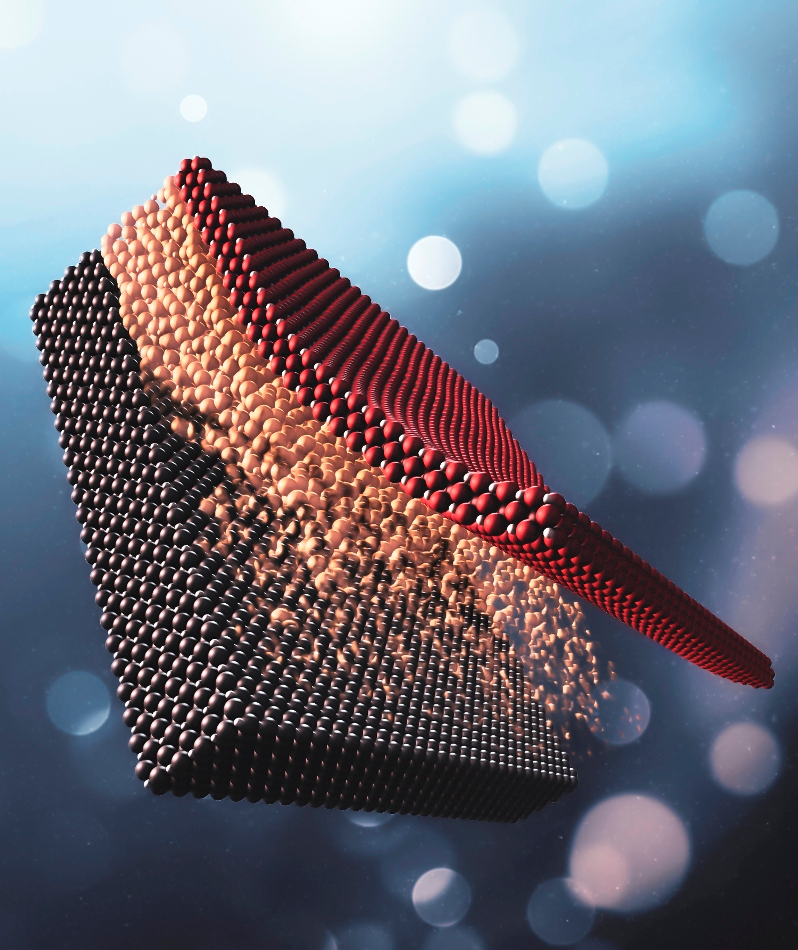Apr 3 2020
A material’s properties can be changed in many ways, and one of the ways is to stretch the material slightly. This pushes the atoms in the material further apart but the bonds between the atoms do not break.
 Researchers from SLAC and Stanford made a super-thin, flexible membrane from a normally brittle oxide by growing it on a surface coated with a compound that dissolves in water. When the coating was dissolved, the membrane (dark red) floated free. Stretching this membrane revealed how strain affects the material’s electronic properties. Image Credit: Greg Stewart/SLAC National Accelerator Laboratory.
Researchers from SLAC and Stanford made a super-thin, flexible membrane from a normally brittle oxide by growing it on a surface coated with a compound that dissolves in water. When the coating was dissolved, the membrane (dark red) floated free. Stretching this membrane revealed how strain affects the material’s electronic properties. Image Credit: Greg Stewart/SLAC National Accelerator Laboratory.
This additional distance impacts the electrons’ behavior and it is these electrons that decide whether the material is a conductor or insulator of electricity, for instance.
However, stretching does not work quite well for a major group of complex oxide materials because they are as fragile as ceramic coffee cups and can potentially break.
Now researchers at the Department of Energy’s (DOE) SLAC National Accelerator Laboratory and Stanford University have identified a new way to overcome this problem in the case of a complex oxide called lanthanum calcium manganese oxide (LCMO).
The researchers developed an ultra-thin, flexible membrane from the usually fragile material, then utilized micromanipulators to expand it on a small apparatus, and finally fixed it in place to maintain the stretch.
When the researchers applied a mild heat to melt the glue, they were able to release and expand the same transparent membrane repeatedly and observed its transformation as an insulator from a conductor, and then back again. The magnetic properties of the membrane also changed upon stretching.
We can really stretch and strain these things dramatically, by up to 8%. This opens a whole new world of possibilities that will have an impact beyond this particular study.
Harold Hwang, Professor, SLAC National Accelerator Laboratory and Stanford University
Hwang is also an investigator with the Stanford Institute for Materials and Energy Sciences (SIMES).
The researchers have recently published their findings in the Science journal.
New Ways to Float Free and Stretch
LCMO is believed to be a quantum material because its electrons act in unusual and often unexpected ways. Researchers wanted to regulate and adjust this behavior for next-generation electronics mainly in detectors, sensors, computing, transportation, and power transmission.
Generally, thin films of quantum materials are produced on another material’s surface. Four years ago, the research team of Hwang reported a simple method to remove those fragile layers so that they could be analyzed in more innovative ways.
Seung Sae Hong, one of the scientists who worked on that research, also headed this one. He employed the latest techniques to produce and free tiny bits of LCMO that were relatively thinner than ever before, measuring less than 20 nm thick. These tiny bits of LCMO were almost transparent and unexpectedly flexible.
It would be difficult to directly stretch such a tiny, delicate scrap but Hong resolved that issue by placing it on a thin polymer film—more or less like a plastic bag available in a grocery store—where it fixed on its own volition.
Hong subsequently fastened the polymer film on each of its four sides and utilized a micromanipulator to pull and stretch it—sometimes in both directions simultaneously, or sometimes in one direction. After stretching the LCMO, its polymer backing can be fixed to another surface and can be transferred to another instrument for X-ray analysis.
Flipping Electronic States
The experiments were quite tedious and difficult. We’d look at the film, warm it to soften the glue and relax the stretch, manipulate it in some other way, freeze it in place and look at it again.
Seung Sae Hong, Assistant Professor, University of California, Davis
The scientists were able to directly quantify the gap that exists between atoms and confirm that this gap indeed increases upon stretching. The team also quantified the LMCO’s electrical resistance and found that stretching changed it from a metallic state, which rapidly conducts electricity to an insulating state, which does not.
When a powerful magnetic field was applied, the magnetic state of the material changed and reverted to the metallic state.
As a scientific tool this is really exciting. It opens opportunities for mechanically manipulating broad classes of materials in ways we couldn’t do before. And it gives us ideas for how we might design flexible materials for electronic devices, including sensors and detectors that measure very small changes.
Seung Sae Hong, Assistant Professor, University of California, Davis
Significant funding for this research was provided by the DOE Office of Science and the Gordon and Betty Moore Foundation’s Emergent Phenomena in Quantum Systems Initiative.
Scientists from the University of Duisburg-Essen in Germany and Northwestern University contributed theoretical modeling for the research.
Calculations were carried out using the National Extreme Science and Engineering Discovery Environment (XSEDE), which is supported by the CARBON Cluster at DOE’s Argonne National Laboratory; the National Science Foundation; and the MagnitUDE supercomputer at the University of Duisburg-Essen.